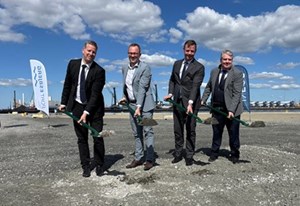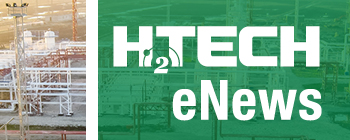News
Greensand begins construction on EU's first CO2 storage facility
Construction has begun on Greensand’s carbon dioxide transit terminal at Port Esbjerg in Denmark. Once operational, the terminal will be a critical component in what is expected to become the EU’s first CO₂ storage facility aimed at mitigating climate change.
Construction in Port Esbjerg is expected to complete in the Autumn this year, at which point INEOS Energy will take over the operation the first gateway for CCS logistics in EU, on behalf of the Greensand consortium.
Greensand has secured liquefied CO₂ from several Danish biogas plants. Once captured, the CO₂ will be transported by truck to the terminal in Esbjerg, where it will be temporarily stored.
When the tanks are full, the liquefied CO₂ will be loaded onto a dedicated carrier from Royal Wagenborg and shipped to the INEOS Nini platform in the Danish North Sea. From there, it will be safely injected via pipeline into subsurface reservoirs approximately 1,800 meters beneath the seabed for permanent storage.
Denmark's leading role in climate solutions and green jobs
In December 2024, INEOS and its partners Harbour Energy and Nordsøfonden made the Final Investment Decision (FID) to launch the commercial phase of Greensand. This paves the way for expected investments of over DKK 1 billion to scale the storage capacity across the CCS value chain.
With plans to initiate offshore injection at the end of 2025 or beginning of 2026, Greensand is set to become the EU’s first operational CO₂ storage site designed to mitigate climate change.
The European Commission estimates that by 2040, the EU will need to store 250 MMtpy of CO2 to meet the Paris Agreement targets. CCS is also considered a key technology for reaching Denmark’s 2045 net-zero goals.
The economic potential is significant: if Denmark captures just 5% of the European CCS market, it could create up to 9,000 jobs and generate an economic impact of DKK 50 billion.
“Port of Esbjerg already plays a key role in the green transition in Denmark and Europe. With the construction of this terminal, the port is well on its way to becoming a central hub for CO₂ capture and storage in the EU – supporting both the climate and the economy,” said Mads Gade.
Denmark holds a unique position thanks to the particularly well-suited geology of the North Sea seabed.
“We’re proud to support Greensand’s ambitious progress. This is one of the most advanced CCS projects globally. By leveraging Denmark’s unique subsurface, Esbjerg can help meet future CO₂ storage needs across Europe,” said Dennis Jul Pedersen.



